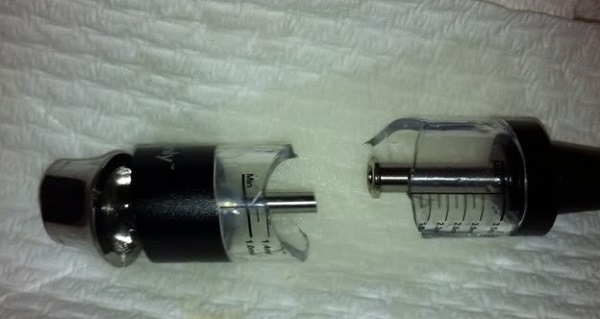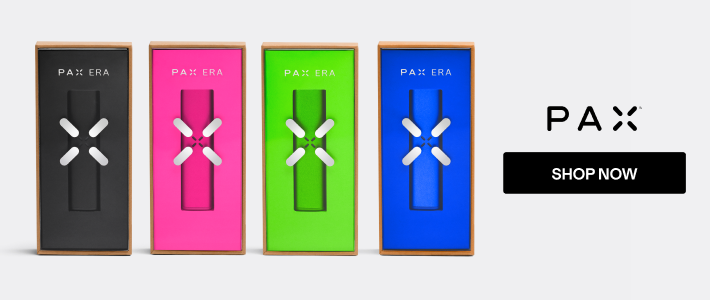E-liquids and tanks don’t always mix. You may be confident in handling e-liquid, refilling and cleaning up any spills, but certain liquid-tank combinations are likely to spell disaster. This may be anything from causing a crack to develop in the body to outright melting the outer casing of the tank.
The good news is that only a relatively small proportion of juices are implicated, and the problem only occurs with plastic tanks. It might not be ideal for you financially, but the risk is removed if you spend a little more for a glass tank.
Key Points
- Only polycarbonate (plastic) tanks are affected, so to remove the risk with specific flavors, invest in a glass one!
- Malic acid, citric acid (both common in fruits) and cinnamon-based liquids are the most common culprits, but there is a master list on the ECF you can use to check specific juices.
- Clean up any spills carefully, remembering that nicotine is a toxin and can be absorbed through the skin. Wipe down affected surfaces, take off and wash any clothes it spills on and put any juice-sodden paper towels in a zip-lock bag before throwing them away.

Glass tanks are great, but not usually necessary. Polycarbonate tanks are the ‘weak’ tanks. Lots of vendors also use a clear PETG plastic which will stand up to most juices. In the end if you want to use a heavy cinnamon juice or citrus juice, don't use it in a [polycarbonate] tank. – Nick “GrimmGreen” Green (GrimmGreen.com)

Just because of those acidic e-liquids, e-cigarette manufacturers are now moving more towards Pyrex glass tanks instead of using the plastic type we're all used to. And, if you haven't yet moved to a glass tank, you'll eventually be forced to. Those plastic tanks will literally melt when in contact with acidic e-liquids and no manufacturer will keep producing a product that will continually cause problems. Manufacturers want to stay up with the times and produce the best product possible, and it's a must especially in this quickly evolving industry. With that said, glass tanks are the future and it's becoming quite apparent with the latest in clearomizers.
Glass tanks may cost you a little more, but I can guarantee you they'll last you longer, they'll be built more durable and they'll also look damn good in the process! – Blake Brown (GuidetoVaping.com)

It really depends on what you vape. If you vape liquids that are known to break down plastic tanks, then invest in a glass tank. There are many available and they're becoming more and more standard. If you have glass, you don't have to worry about the liquid. Just be careful… it's glass! No matter what the quality, or the amount you paid for it, if you hit it with a hammer, it's gonna break! So when you drop it on your concrete driveway and it breaks (it's happened to me) don't be too surprised. – Phil Busardo (TasteYourJuice.com)

If you are a fan of acidic e-liquids like some citrus flavors, and especially cinnamon you pretty much need to go for a glass tank, or spend a lot of money replacing plastic tanks. Fortunately, there are now a lot of choices for glass tanks, and some are reasonably priced. There are also all metal replacement tanks for things like the Vivi Nova and DCTs. – Steve K (Steve K’s Vaping World)
E-Liquids Can Damage Polycarbonate (Plastic) Tanks

Polycarbonate plastic is at the root of the issues with certain liquids and tanks. The material holds up pretty well to a dilute acid, but it can’t handle strong acids or bases. This is why most of the problems come from malic acid or citric acid containing juices, often fruit-flavored options like orange or pineapple-based juices. Not only do you lose a tank, you also suffer a juice leak all over your e-cig and whatever surface it was resting on. From the earlier sections on nicotine, you should be well aware that this is a potential hazard, and if it happens when you’ve left your e-cig somewhere you may not even be aware of the spill.
This is why it really is worth getting your hands on a glass tank, or alternatively one made from PETG (a more chemically resistant plastic) or metal. It means you can enjoy e-liquids freely without any risk of a bad reaction with some juice.
In addition, there is some evidence that bisphenol A (commonly referred to as BPA) leaks out of polycarbonate containers for drinks, and the chemical has been linked to cardiovascular disease. It’s used in the manufacture of polycarbonates, so it’s reasonable to assume that polycarbonate (plastic) tanks also leak BPA into your juice. It isn’t a major concern (since you likely use plastic bottles containing it anyway), but still another argument in favor of going with glass or another material for your tanks.
Which E-Liquid Damages Tanks?
There are many e-liquids implicated, but it’s broadly fruit flavors high in malic acid and citric acid, including lemon, lime, banana, mango, grape, grapefruit and pineapple. Here is a list of e-juice flavors that may break your plastic tank.
Additionally, cinnamon-based liquids are often the culprits, which may be due the alkaline nature of cinnamon flavoring. Often, if an e-liquid manufacturer or distributor learns that specific flavors of theirs have cracked plastic tanks, they’ll put a note up on the website so you can avoid the problem.
There is a master list of affected flavors on the ECF, so if you’re in doubt, check to see if your juice (or a similar one, flavor-wise) is listed there. Of course, these are just based on reports, and damage accumulates over time, so not all of these juices are necessarily going to break your tank – it’s just not worth the risk.
Additionally, the list is by no means absolute, so just because it’s not listed doesn’t mean it’s definitely safe. Use the general rules about the affected flavorings and exercise caution if you’re in doubt. There are plenty of flavors, so if you have a polycarbonate tank it’s just better to go for other options.
Conclusion – Get a Glass Tank!

This is an unfortunate issue, but it’s one that can be resolved very simply: get yourself a glass tank and vape away. If you do fall foul of an e-liquid-tank incompatibility, follow the rules established earlier on the safe cleaning of spills and don’t make the same mistake again!
The Complete Guide to E-Cig Safety
Part One: Beginner E-Cigs Safety
1. Safe Use of Beginner E-Cigs
2. A Guide to Safe Charging
3. Carrying Your E-Cig Safely
4. Cartomizer Safety
5. Vaping and Driving
Part Two: E-Liquid Safety
6. Basic E-Liquid Safety
7. Allergies, Conditions and E-Liquid
8. Safe Nicotine Consumption for Vapers
9. Steeping E-Liquids Safely
10. Do E-Liquids Expire?
11. E-Liquid and Tank Safety
12. DIY E-Liquid Safety
Part Three: E-Cig Mod Safety
13. Minimizing the Risk of E-Cig Mod Explosions
14. E-Cig Mod Battery Safety and Ohm’s Law
15. Rebuildable Atomizer Safety
16. Mechanical Mod Safety
17. Wick Safety
18. Drip Tip Safety

